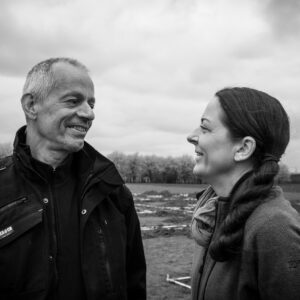Driessens & Verstappen
Meta.Morf 2024 – [up]Loaded Bodies / Kjøpmannsgata Ung Kunst / April 18 – August 18 /
Curators: Zane Cerpina, Boris Debackere, Espen Gangvik, Florian Weigl.
Pareidolia (2019)
It is a fascinating idea that all the faces of all the people who have ever lived and will ever live, may be found within the enormous quantity of grains of sand existing on earth. And even though finding a face is very rare, you know that innumerable faces are concealed among them, if you search long enough in the well-nigh inexhaustible volume. Pareidolia* is a fully automatic robotic search engine scrutinizing grains of sand in situ.
This proceeds as follows: there is a dosing funnel in the machine that sprinkles the sand across a slowly rotating glass disc. The microscope above the disc detects the individual sand particles and applies face detection software to each of them. If a face is discovered within the scattered grains, a portrait will be recorded photographically. All photos are unedited and true representations of the grains in question. Finally, there is a swiper swiping the sand that has traversed around the circuit away, making space for new grains. In addition to the optics and the mechanics of the robot installation, the artists developed the face detection software themselves, utilizing AI and artificial neural networks.
The artists keep a tally of the top 100: as more grains are evaluated, this top 100 comprises ever better faces. The top 100 are shown on a large screen and its rounded form refers to the ocular nature of the microscope.
The work offers a more profound insight into the morphology of sand grains and the inconceivable number of their unique variants. In addition, the work comments in a playful and absurdist manner on the extreme implementation of an anthropocentric worldview, whereby everything revolves around Man who wishes to see his own image even in the tiniest grain of sand.
*Pareidolia is an illusion in which the observer perceives something recognizable in something it is not.
Pareidolia is supported by the Dutch Creative Industries Fund.
 Driessens & Verstappen (NL)
Driessens & Verstappen (NL)
The Amsterdam-based artist couple Erwin Driessens (1963 Wessem) and Maria Verstappen (1964 Someren) have worked together since 1990. After their study at the Maastricht Academy of Fine Arts and the Rijksakademie Amsterdam, they jointly developed a multifaceted oeuvre of software, machines, and objects. Their research focuses on the possibilities that physical, biological, and computer algorithms can offer for the development of image-generating processes. They strive for an art in which spontaneous phenomena are generated systematically. Art that is not entirely determined by the subjective choices of a human being but instead is created by autonomously operating processes. A major source of inspiration is the self-organizing processes in nature, especially the decentralized processes, the bottom-up processes that have their attention. In addition to working with natural processes, they use the computer to program digital processes that generate fictional worlds.
Driessens & Verstappen participated in numerous exhibitions a.o. Stedelijk Museum Amsterdam, Museum Boijmans van Beuningen Rotterdam, Centre Pompidou Paris, Garage Museum Moscow, IVAM Institute Valencia, Museum Kröller-Müller Arnhem, Neue Pinakothek München, Les Abattoirs Toulouse, V2_ Rotterdam, Eyebeam New York, Science Gallery Dublin. The couple gives lectures and presentations at universities, art academies, festivals, and conferences, a.o. Siggraph Los Angeles, Sonic Acts Amsterdam, Second Iteration Melbourne. In 1999 and 2001, their Tickle robot projects were awarded first prize at VIDA Telefónica Spain, an international competition for Art & Artificial Life. In 2013, the couple received the Witteveen+Bos Art+technology Award for their entire oeuvre. The artists are represented by gallery DAM in Berlin.
Header Graphics: “Pareidolia” installation by Driessens & Verstappen, photo: Helen Vink.
Portrait photo: Simone de Kinderen.